The best mattress protectors tried and tested – I've found the best waterproof, cooling, and budget options from M&S, Dunelm, and more
I slept on multiple mattress protectors to find the best-in-class for waterproofing, night sweats, and cooling comfort


Why you can trust Ideal Home
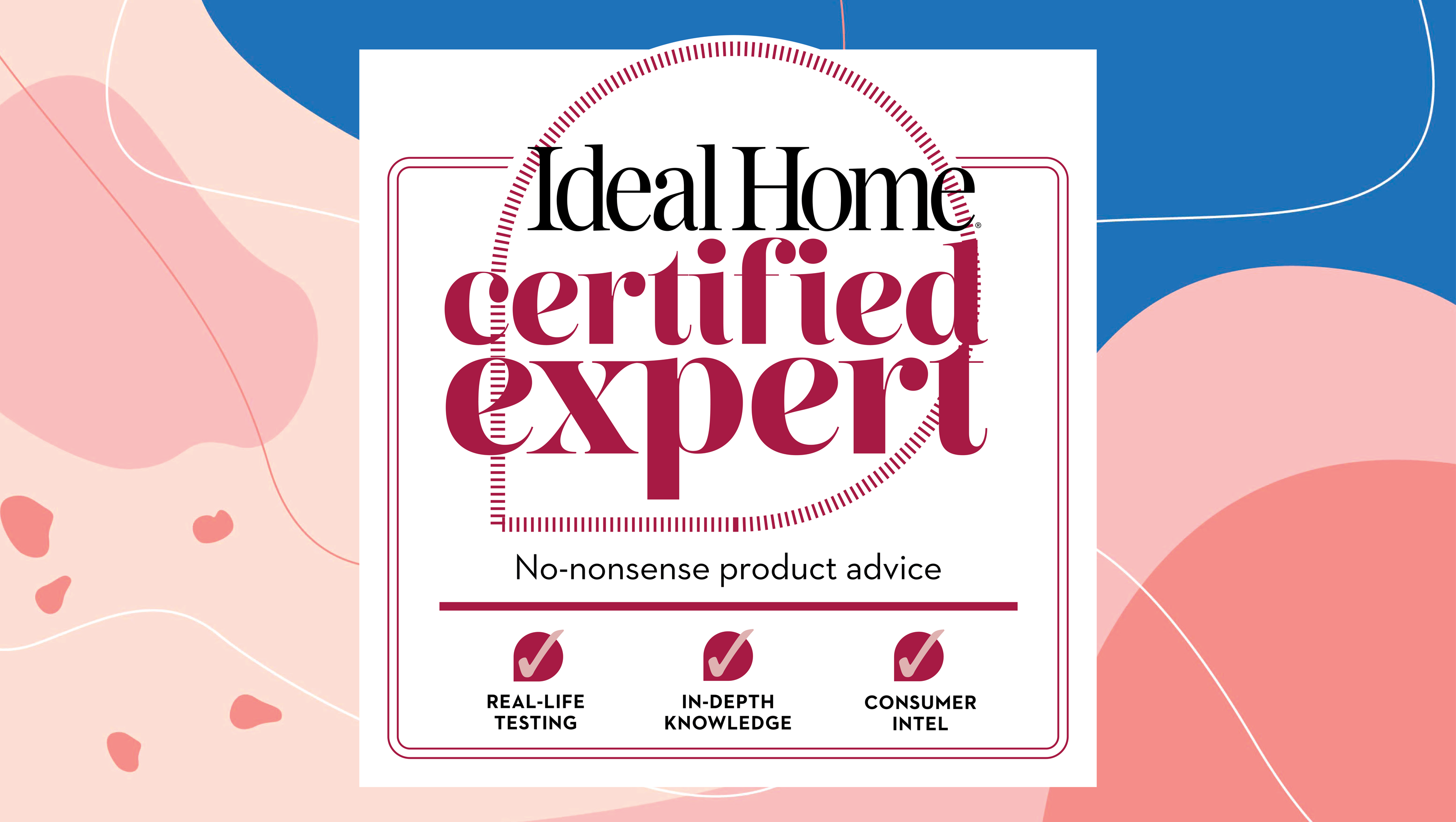
- 100 years of industry expertise
- 10,000 hours of sleep product testing
- 10 bestselling mattress protectors tried and tested at home
The best mattress protectors are an essential addition to any sleep set-up, providing a barrier that shields our mattress from sweat, body oils, dead skin cells (yuck!), and general dirt and grime.
A waterproof mattress protector will also protect a mattress from bedwetting or accidental liquid spills, whilst a zippered protector or mattress encasement can defend our mattress from dust-mites, allergens, and bed bugs.
As Ideal Home's Sleep Editor, a mattress protector is a bedding essential I recommend everyone purchases. After all, the best mattresses are expensive, so we all want to make sure our investment stays in top condition for as long as possible.
The good news is that you don't need to spend a fortune to get a decent mattress protector, with options starting from under £15. I've tested ten of the best on my own bed, assessing each for comfort and performance, and rounded up my top recommendations below.

The quick list
Short on time? This quick list is an overview of the very best mattress protectors. You'll find more information on each product and why I recommend it if you keep on scrolling.
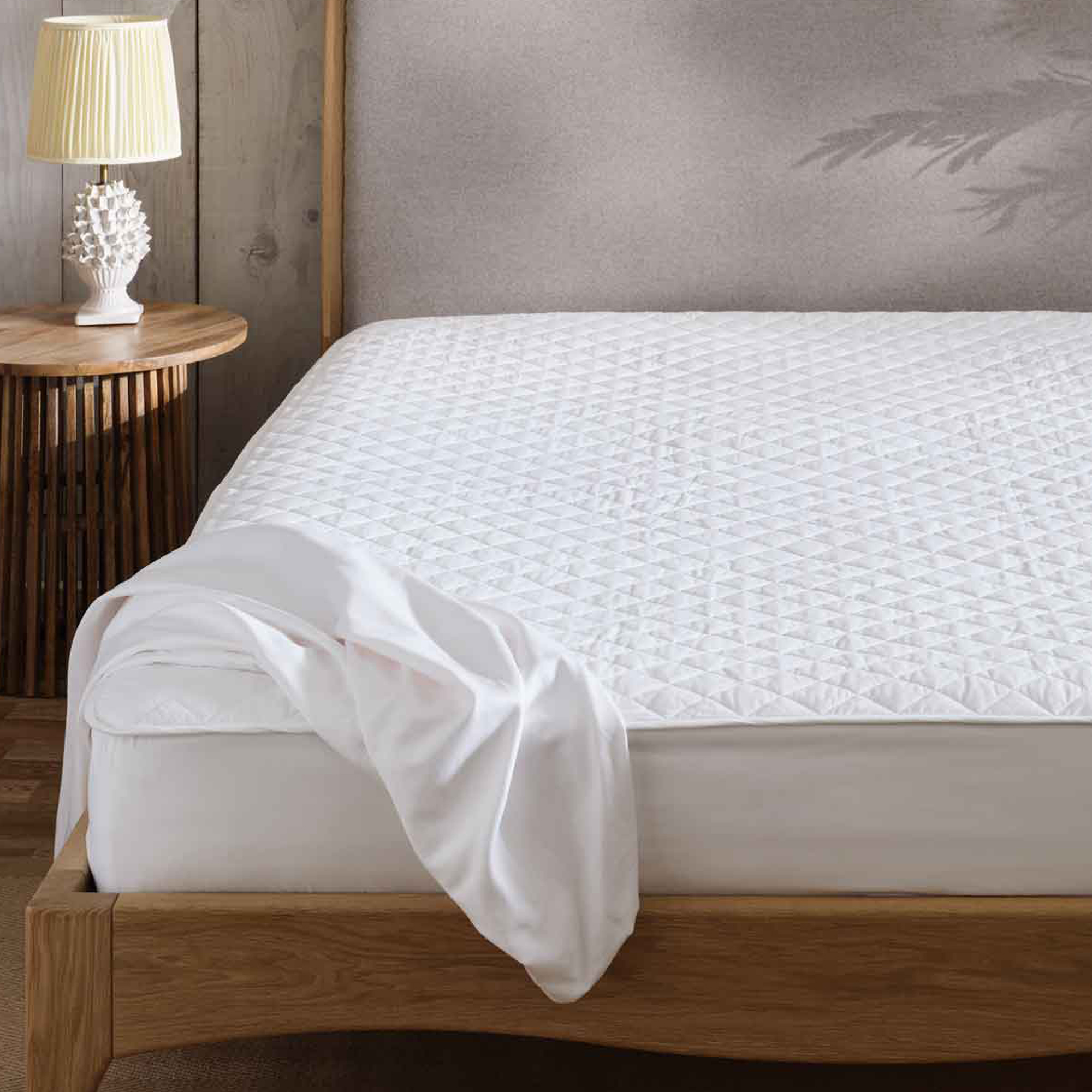
Best mattress protector overall
It's incredibly difficult to find a mattress protector made from all-natural materials, but this scooms protector is just such a find. Its lack of synthetic quilting delivers a cool and breathable sleep, and as long as you don't need waterproofing it's one of the best I've tested.

Best budget mattress protector
If you want an affordable way to protect your mattress, then this synthetic mix protector does a great job. It's super soft, silent, budget-friendly and easy to care for, as a hot sleeper I just found it was prone to making me overheat on warm nights.

Best waterproof
If you need a waterproof mattress protector that can handle large spills like bedwetting, the Coolmax is 'the one'. It's comfortable, relatively quiet, and its super absorbent padding can hold a large amount of liquid whilst protecting your bed.

Best budget waterproof
Its terry towelling upper can't absorb anywhere near as much liquid as the best-in-class Coolmax waterproof mattress protector, but its waterproof membrane still protects your mattress from spills, and if you're on a budget, it's far more affordable.
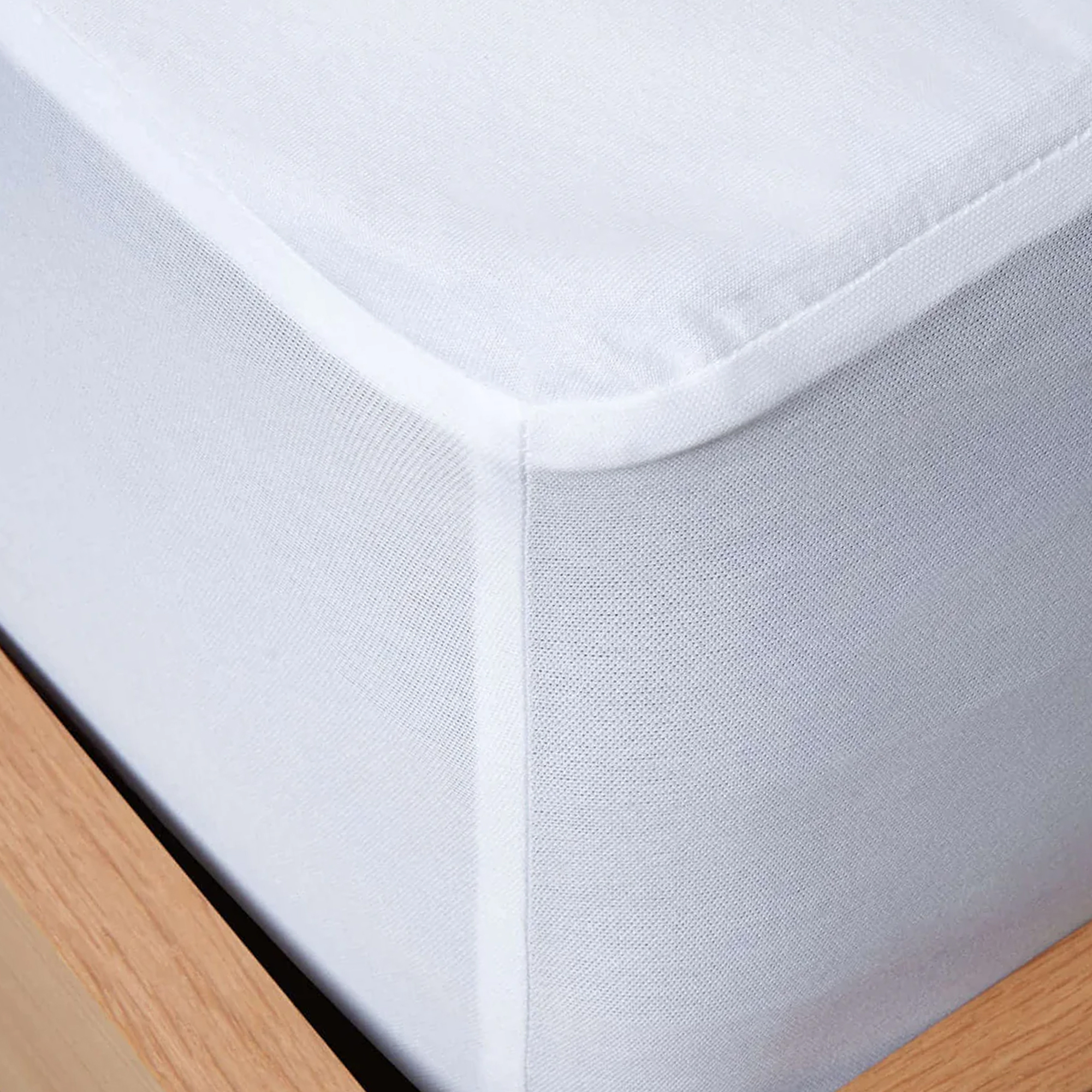
Best for night sweats
This waterproof mattress protector is quiet and super discreet. Its thin flexible design doesn't absorb much liquid (so for bedwetting, the Coolmax wins out), but if you want to protect your mattress from sweating or hot flushes, it's perfect. As a hot sleeper, I also found it more breathable than most waterproof options.

Best for hot sleepers
It's an investment, but as a hot sleeper, this mattress protector transformed my sleep. It's breathable organic cotton cover and temperature-regulating wool quilting enabled me to sleep far cooler at night and virtually eliminated overheating when I added it to a memory foam mattress.
Best mattress protector overall

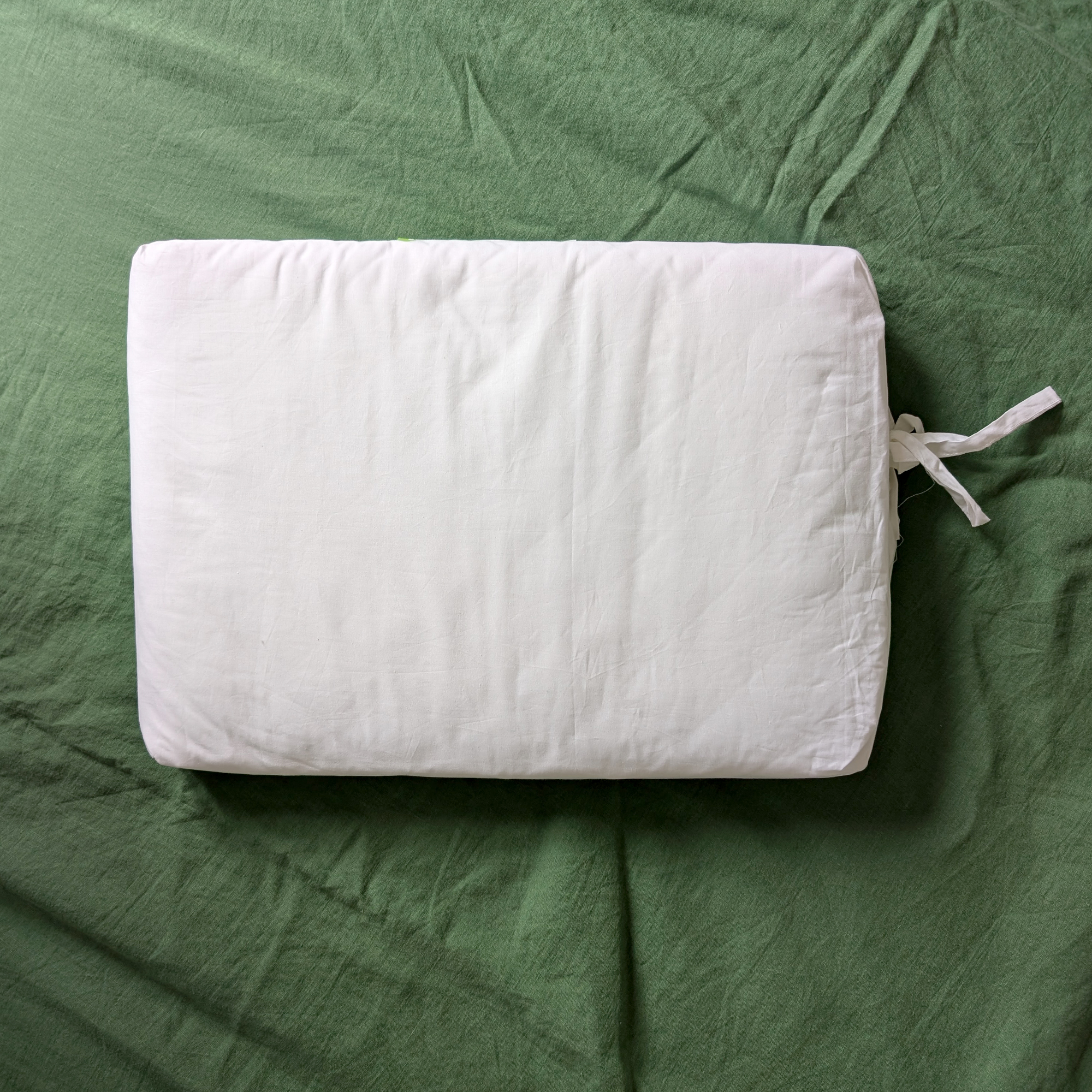
scooms 100% Pure Cotton Mattress Protector
Specifications
Reasons to buy
Reasons to avoid
Feel: It's incredibly difficult to find a cotton mattress protector that's actually pure cotton. Most have a layer of synthetic quilting inside, and if you tend to sleep warm, like me, that can mean overheating at night. However, the scooms Pure 100% Cotton Mattress Protector is exactly what it promises, which means it's super breathable and leads to no overheating. It's not cheap, but its quality was head and shoulders above any other cotton mattress protector I tested, including the M&S Pure Cotton Mattress Protector (which I found was loose-fitting and wrinkled on the bed).
Noise: There's no noise at all with this protector, instead I enjoyed a completely silent sleep.
Waterproofing: This protector isn't waterproof, but, its quilting is thick enough that it kept any light moisture like sweat well away from the mattress.
Fit: A deep skirt means this mattress protector can fit a mattress up to 40cm in depth, so it's a good option if you want a protector to fit over a mattress that has a topper attached. It's designed to be slightly oversized when unboxed to allow for natural shrinkage when it's first washed, and although it was a little baggy before I put it through the washing machine, I still found it stayed in place on my 25cm deep mattress perfectly well.
Ease of care: I found this protector washed well. scooms advises it's machine washable at 30-40°c and can then be low tumble dried. However, because it's not synthetic I found it did take longer to dry than a polyester-mix protector.
Best budget mattress protector

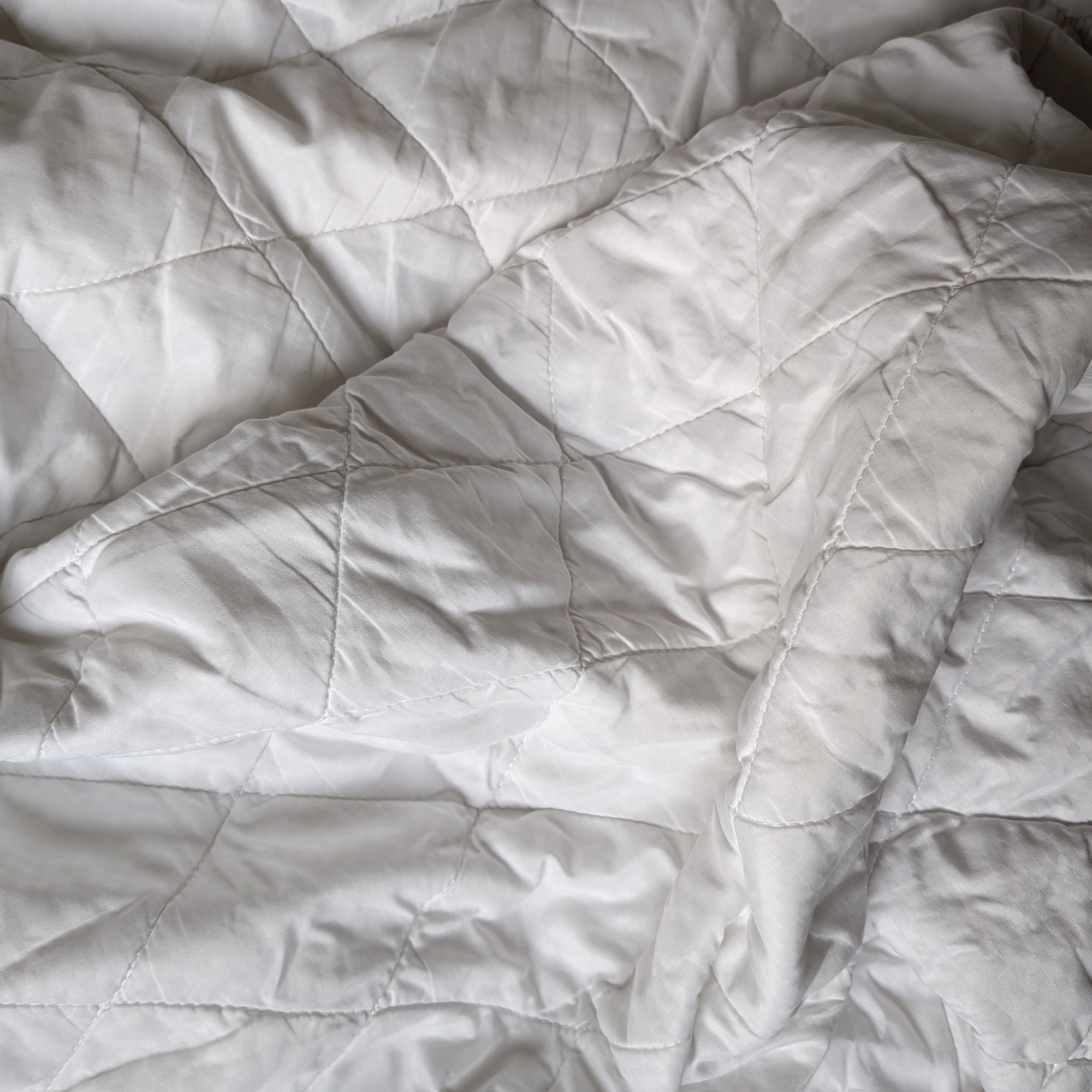
Dunelm Fogarty Soft Touch Mattress Protector
Specifications
Reasons to buy
Reasons to avoid
Feel: Considering its price, this protector costs between £14 and £25, depending on size, the Fogarty Soft Touch Mattress Protector feels really quite luxurious. It's as soft as its name might suggest, and it makes for a really comfortable sleep surface. The only issue I found was that its synthetic polyester cover and quilting made me overheat. If you're not a hot sleeper, this may not be a problem for you, but if you are, I'd suggest opting for a pure cotton protector (like the scooms option above) or a wool-filled protector (like the Woolroom Deluxe Washable Wool Mattress Protector below) instead.
Noise: I noticed a very tiny bit of rustling when my sheet moved against the polyester protector underneath, but it's barely noticeable.
Waterproofing: Nope, no waterproofing here. But, the quilting is filled with a light layer of hollow fibre polyester that keeps any light stains or sweat lifted away from the surface of your mattress.
Fit: I tested the 30cm deep version of this protector and found it fitted my 25cm deep mattress well, but there's also a 35cm option if you have a deeper bed.
Ease of care: Because this protector is made from polyester, I found it super easy to care for. I stuck it in the washing machine and tumble dried it on low, and it was ready to put back on the bed in record time.
Best waterproof mattress protector


Soak & Sleep Waterproof Coolmax Mattress Protector
Specifications
Reasons to buy
Reasons to avoid
Feel: This is the most cushioned mattress protector I've tested. In fact, it feels almost like a mattress topper thanks to its top layer of quilted polyester. That quilting isn't just there to absorb liquid; I found it also added an extra layer of softness to my bed. Whilst I can't say it felt cool to sleep on – the Panda Bamboo Mattress Protector is the coolest waterproof option I've found – as a hot sleeper, it didn't cause me to overheat like many waterproof mattress protectors have. It felt warm underneath me, but not overly so.
Noise: I found this protector a little bit rustly when on the bed, but definitely not enough to disturb my sleep, and still quieter than most waterproof mattress protectors.
Waterproofing: This is where the Coolmax really excels. Not only is it waterproof, but its thick quilting is also super absorbent. I poured a full glass of water onto it, and all of the liquid was quickly absorbed with no runoff over the edge of the bed, as with most other waterproof mattress protectors. If you're looking for a mattress protector that can cope with bedwetting, this is it.
Fit: I found its thin elasticated skirt really easy to fit to my mattress and it was true to size. It only comes in a 35cm skirt depth, but that should fit most standard mattress sizes.
Ease of care: Machine washable at 40°C, this protector is easy to care for. Although it can hold such large amounts of liquid, I found that its polyester wadding was still quick to dry. You can low tumble dry or line dry.
Best budget waterproof mattress protector

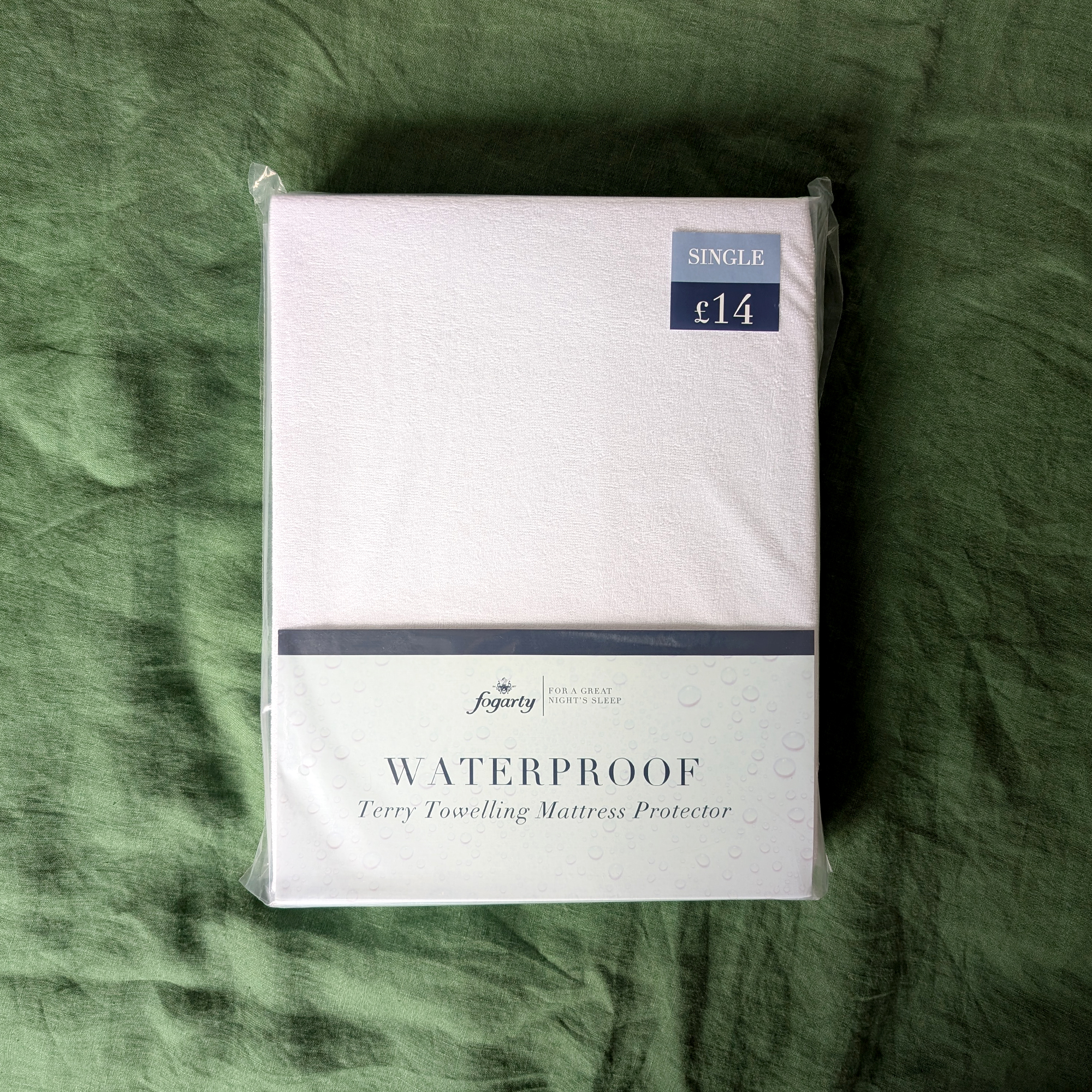
Fogarty Terry Towelling Waterproof Mattress Protector
Specifications
Reasons to buy
Reasons to avoid
Feel: This is a waterproof terry towelling protector, so it has plastic backing with a thin layer of terry towelling on the surface. Considering its budget price tag I was really impressed by its quality. It feels a lot thinner and more flexible than most waterproof mattress protectors I've tested at this price point and felt pretty comfortable to lie on on the bed. I also tested the M&S Sleep Solutions Terry Waterproof Mattress Protector which is a similar price, and the Dunelm option felt far more flexible and less stiff and crunchy on the bed. Its main downside was that I found it slept very warm and caused me to overheat, but this has been the case with every waterproof protector I've tested at this price point.
Noise: Its waterproof backing does mean that there's a little rustling noise when this protector is on the bed, but it's far quieter and less 'crunchy' sounding than any other waterproof mattress protector at this price point. However, it can't compete with the Panda Bamboo Mattress Protector – that's still the quietest waterproof option out there.
Waterproofing: When I poured a glass of water over this protector there were no leakages. The terry towelling did also absorb a little liquid, but only a little, so a lot of water still spread out across the protector and threatened to run off the sides. If you're after absorbancy, the (more expensive) Soak & Sleep Waterproof Coolmax Mattress Protector is definitely the best buy.
Fit: This budget waterproof mattress protector only comes in one 30cm depth. That should be fine for your average mattress, but if yours is deeper than usual, or you have a mattress topper on the bed, it may be too shallow.
Ease of care: You can machine wash this mattress protector at 60°C, but you can't put it in the tumble drier. However, I still found it dried pretty fast on the line or over a clothes horse.
Best for night sweats


Panda Bamboo Mattress Protector
Specifications
Reasons to buy
Reasons to avoid
Feel: This is one of the thinnest waterproof mattress protectors I've come across. There's no quilting, just a bamboo and polyester fabric layer with a waterproof TPU backing. As such it's super flexible – meaning there's none of that uncomfortable stiffness that many waterproof protectors end up with – and super discrete; you'd never know there was a waterproof mattress protector on the bed when you lie down.
Noise: Because of the waterproof TPU backing there was the tiniest hint of a rustle when I turned over on this protector, but it's by *far* the quietest waterproof mattress protector I've tested. You hardly know it's there so it's super discrete.
Waterproofing: This protector is so thin I was initially dubious that it was actually going to be waterproof. However, when I emptied a glass of water over the surface I was incredibly impressed; there was absolutely no dampness on the other side. The only downside is that its thin fabric means there's very little absorbancy; perfect for protecting your mattress from night sweats or hot flushes, but larger amounts of liquid are potentially going to run off the protector, so perhaps not the best bet for bedwetting.
Fit: The Panda Bamboo Mattress Protector only comes in one 32cm depth, which should fit most beds fine. It's also so light and flexible I found it the easiest protector to add to my bed. But, if you have an extra deep mattress or a mattress topper on your mattress you may find you need an option with a deeper skirt.
Ease of care: Because of its waterproof TPU backing I was surprised that the care label suggests the protector can be machine washed at 50°C and low tumble dried, but yet again my concerns were unfounded and it washed and dried well!
Best for hot sleepers






Woolroom Deluxe Washable Wool Mattress Protector
Specifications
Feel: Where this cotton protector with a layer of wool quilting really comes into its own is temperature regulation. I first tested this protector on a memory foam mattress that was causing me to overheat, and having not slept on wool bedding before then, I was amazed that it instantly made for a cooler and more breathable sleep. In fact, I think this protector can give some of the best cooling mattress toppers a run for their money. If you're a hot sleeper, I thoroughly recommend giving this protector a try, and it comes with a 30-night sleep trial so you can do just that.
Noise: Joy of joys, this protector is completely silent!
Waterproofing: No waterproofing, but its layer of wool quilting keeps any stains lifted up away from the mattress surface.
Fit: When I first unpacked this protector, it came as a bit of a surprise that it was off-white rather than the brilliant white, highly-bleached bedding I've become used to, but its unbleached organic cotton is far kinder to the environment. I found its 35cm cotton skirt a little baggier than stretchy polyester options, but it still fit my smaller 25cm deep mattress well.
Ease of care: Because this mattress protector has wool quilting, it is a little more fussy to look after than a synthetic protector, but only a little. It's machine washable on wool/delicate cycle at 40°C – and it came out of my machine exactly the same size it went in, phew! – but it is line dry only rather than tumble dry.
How I tested
There's really only one way to test a mattress protector, and that's by sleeping on it, so that's what I did in order to compile this guide. I've slept on ten (and counting) bestselling mattress protectors for a week each to compile this shortlist, and have only included those products that performed the best.
In the process, I assessed how easy each protector was to put on my bed, how well it fitted the mattress, and if it stayed on securely. I also assessed comfort and if the protector caused me to overheat during the night, and if it rustled or made any noise.
For the waterproof options I poured a glass of water onto the protector and assessed whether there was any leakage through to the back of the protector. I also assessed the absorption or runoff of liquid. Finally, I washed each mattress protector to see how easy it was to care for.
Where possible, I've also thoroughly researched third-party customer reviews to see what other owners have to say about their sleep experience. All the mattress protectors included in this guide regularly get 4-5 star reviews from owners.

I'm Amy, and as Ideal Home's Sleep Editor I've spent the last four years testing sleep products by night and sharing my findings with our readers by day. All in all, that's over 10,000 hours of at-home product testing under my belt!
How to choose the best mattress protector for you
These are the six main factors you'll want to consider when choosing the right mattress protector for your needs.
Waterproofing: If you need to protect your mattress from bedwetting then you’ll want a waterproof mattress protector. These feature an impermeable plastic membrane that prevents moisture from penetrating through the protector and reaching the mattress. You can get waterproof mattress protectors (where just the top of the protector is waterproof) or zippered waterproof mattress encasements (that protect all six sides of the mattress from moisture).
However, a waterproof mattress protector does come with downsides – largely that the plastic underlayer lacks breathability, can feel a little ‘plasticky’ underneath your bedsheet, and can rustle. So if you aren’t worried about bedwetting, it can be best to avoid a waterproof mattress protector and opt for a more breathable option instead. More on that next.

Breathability: Bedding made from synthetic materials such as polyester is likely to cause overheating as these materials lack breathability. Instead these materials tend to reflect body heat and humidity back towards the sleeper which can lead to us waking up hot and sticky in the night. Alternatively, natural materials such as cotton and wool allow for better air circulation. Better air circulation means the body can regulate its temperature better, which makes for a less disturbed and more restful night’s sleep.
Allergies and bed bugs: If you want to protect your mattress from allergens such as dust-mites or bed bugs then the safest way to do so is to opt for a zippered mattress protector (also known as a mattress encasement) that covers all six sides of your mattress.
Fit: Make sure that the mattress protector you choose is the right size for your mattress, e.g. if you have a double bed, you’ll need a double mattress protector.

Ease of care: Look for a mattress protector that’s machine washable so it’s easy to clean and care for. As Karen Innes, New Product Development Manager at bedding manufacturer Slumberdown says, 'something often overlooked is washing your bedding, and your mattress protector is no exception - choose a mattress protector that is machine washable and try to get into a washing routine with your bedding to prevent any build-up of sweat, oil and dirt.'
Environmental impact: Synthetic polyester mattress protectors are usually the cheapest option, but they’re derived from petrochemicals which are non-renewable, hard to recycle, and don’t biodegrade easily, so they’re the most harmful to the environment. Instead, try to opt for a mattress protector made from natural materials, such as cotton, wool, or even bamboo, instead.
FAQs
What is a mattress protector?
Still not entirely sure what a mattress protector is? Essentially, a mattress protector is a layer of fabric that covers the surface of your mattress to protect it from dirt, stains, and moisture.
A mattress protector generally has a top layer made from cotton or polyester and a layer of light wadding below this. The wadding is designed to keep any stains lifted up away from the mattress surface, it's usually only 1cm or so thick, but this can be enough to absorb sweat, skin cells, and any dirt or grime without them reaching the mattress.
Alternatively, a waterproof mattress protector is essentially a plastic sheet that covers the mattress to protect it from liquids such as urine or excessive sweat. More expensive waterproof mattress protectors will have a layer of fabric and wadding above the plastic membrane to make them more comfortable to sleep on, and some feature thick terry towelling to help absorb moisture.
What is the best mattress protector to prevent sweat stains?
During testing, I found the best mattress protector to prevent sweat stains to be the Panda Bamboo Mattress Protector. It's super thin and super discreet, and most importantly, its waterproof membrane somehow also remained breathable, so I didn't overheat as I have on most other waterproof mattress protectors (which of course then makes sweating worse!).
Do you put a bed sheet over a mattress protector?
Yes, I would always add a flat or fitted sheet over a mattress protector. The sheet acts as an added layer of protection, and generally looks nicer and is more comfortable to sleep on than sleeping directly on the mattress protector itself.

Should you choose a mattress protector or a mattress topper?
A mattress protector and a mattress topper are two different things. You can find out more in our guide to mattress toppers vs protectors. However, in a nutshell, a mattress topper is a thick cushioned layer designed to add extra comfort to a mattress that otherwise feels too firm. Whereas a mattress protector is a thin fabric layer designed purely to protect your sleep surface from accidental stains, moisture, or allergens.
In my opinion, all mattresses should be fitted with a mattress protector to keep the mattress below clean and hygenic. Whereas not everyone needs a mattress topper.
However, if your bed is too firm, you may want to add one of the best mattress toppers to your bed to increase its comfort or breathability. In this case adding a mattress protector over your topper will also help to keep your topper clean!
Do mattress protectors make a difference?
A mattress protector may at first seem like an unnecessary add-on, but, adding one to your sleep set up will do wonders for keeping your mattress guarded against spills, damages and dirt that may seep through your sheet (even without you realising it).
Ever noticed some marks or yellow stains on your mattress, but are unsure where they’ve come from? Yep, a mattress protector will take the stain instead, leaving your mattress fresh underneath. This all contributes to the longevity of your mattress.
How often should you wash a mattress protector?
You can opt to wash your mattress protector as often as you wash your sheets, which is generally advised once a week, or at minimum once a fortnight. However, because you'll have a sheet over the mattress protector it may not need washing quite so frequently, and you might find once a month is enough.
How you wash the protector or encasement will depend on the type of protector and the material it’s made from. Our guide to how to wash a mattress protector has more detail, but, in short, always refer to the care instructions on the mattress protector before washing.
Get the Ideal Home Newsletter
Sign up to our newsletter for style and decor inspiration, house makeovers, project advice and more.

Amy is Ideal Home’s Sleep Editor and the Ideal Home Certified Expert on Sleep. She's spent the last four years researching and writing about what makes for the best night’s sleep during the day and testing out sleep products to find the best-in-class by night. So far she’s clocked up over 10,000 hours of pillow, duvet, and mattress testing experience.
Our go-to for all things sleep-related, she’s slept on and under bestselling products from Simba, Emma, Hypnos, Tempur, Silentnight, Panda, and many many more.
As a hot sleeper, Amy is always on the lookout for the most breathable bedding, but she also leads a wider team of testers to ensure our product testing encompasses both hot sleepers, cold sleepers, front sleepers, back sleepers, side sleepers, and everything in-between.
-
 5 signs you’ve taken decluttering too far — and how you can pull yourself back, according to organisation experts
5 signs you’ve taken decluttering too far — and how you can pull yourself back, according to organisation expertsYou might have to start resisting the urge to purge
By Lauren Bradbury
-
 What is the Party Wall Act 3m rule and is it something you should be worried about? This is what the experts say
What is the Party Wall Act 3m rule and is it something you should be worried about? This is what the experts sayDon't get caught off-guard by the Party Wall Act 3m rule — our expert guide is a must-read
By Natasha Brinsmead
-
 Shoppers can’t get enough of The Range’s lemon tree, but I’ve found an even cheaper bestseller at B&Q - it’s perfect for a Mediterranean look
Shoppers can’t get enough of The Range’s lemon tree, but I’ve found an even cheaper bestseller at B&Q - it’s perfect for a Mediterranean lookWelcome the summer with this glorious fruit tree
By Kezia Reynolds